

Lumos 2019 UNGA Ending Institutionalisation. SIMON NJOROGE - Battle for the Family's Soul: Anatomy of the Orphanage Phenomenon in Kenya. Orphanages, alternatively referred to as children’s homes or charitable children’s institutions as per the Children Act 2001, have been in the headlines in the recent past for a myriad of allegations ranging from abuse and neglect of children, recruitment of children from poor families and involvement in a cartel of traffickers in the guise of adoption that has involved adoption societies, lawyers, children’s officers and judicial officers.
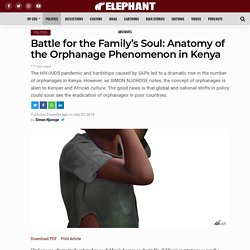
The dramatic case of Matt and Daisy Mazzoncini is the latest in a series of explosive exposés on orphanages and adoption in Kenya. While all the focus has been on these emerging cases and the ensuing drama, a more profound discourse concerning the suitability of the orphanage as a model of care and protection of children has been ongoing for some years among policymakers, practitioners and childcare advocates. Deinstitutionalisation Is the ongoing onslaught on childcare service providers related to the broader deinstitutionalisation discourse? Why the institutionalisation of children must end: key facts.
Translate This About Hundreds of thousands of children are still growing up in institutions in Europe today[1].
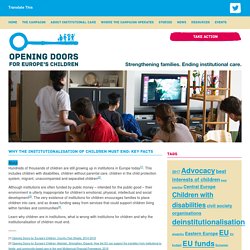
This includes children with disabilities, children without parental care, children in the child protection system, migrant, unaccompanied and separated children[2]. Although institutions are often funded by public money – intended for the public good – their environment is utterly inappropriate for children’s emotional, physical, intellectual and social development[3]. The science of early adversity: is there a role for large institutions in the care of vulnerable children? - The Lancet.
Live interview Monique Derrez in L1mburg Centraal - 6 november 2018. Lumos Stories: Together We Stared at the Moon. Hidden home truths about children's homes. By ELVIS ONDIEKIMore by this Author By KAREN MBUYA MURIUKIMore by this Author The festive season is approaching and, in a few weeks, many Kenyans are expected to throng children’s homes with lavish donations as has been the tradition.
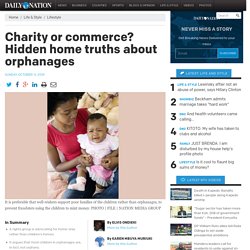
No hugs, no one to talk to: how Ugandan orphanages are harming a generation. At a Catholic orphanage for children aged seven and under near Kampala, a noisy tangle of children moves around the complex.
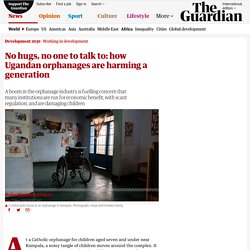
It takes a moment to notice that the children aren’t actually speaking, or even attempting to form words. Instead, they’re shrieking and squawking; they scream at each other as they squabble over toys, cling like burrs to the legs of any passing adult and stare mutely when they’re spoken to. This is common – children who grow up in the orphanage have few chances for conversations with harried staff, and are rarely read stories.
Time. Orphanages, as we all know from Charles Dickens, studies of kids from former Eastern Bloc countries and the musical Annie, are bad for children.
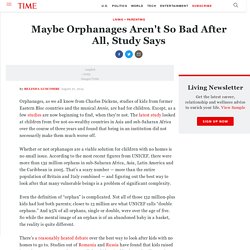
Except, as a few studies are now beginning to find, when they’re not. The latest study looked at children from five not-so-wealthy countries in Asia and sub-Saharan Africa over the course of three years and found that being in an institution did not necessarily make them much worse off. Whether or not orphanages are a viable solution for children with no homes is no small issue. According to the most recent figures from UNICEF, there were more than 132 million orphans in sub-Saharan Africa, Asia, Latin America and the Caribbean in 2005. That’s a scary number — more than the entire population of Britain and Italy combined — and figuring out the best way to look after that many vulnerable beings is a problem of significant complexity. Even the definition of “orphan” is complicated. Die Story vom 22.08.2018 - Kritisch Reisen: Gutes tun im Urlaub - und wer daran verdient. US Govt TIP report 2018 Child Institutionalization section. Statement by Center Director Jack P. Shonkoff, M.D. on Separation of Families - Center on the Developing Child at Harvard University.
The policy of separating families is a critical issue that transcends political ideology and partisanship and speaks to the heart of what the mission of the Center on the Developing Child is all about.

June 20, 2018 Two critical concepts at the core of our understanding of early childhood development stand out from decades of scientific research. First, healthy brain development in babies and young children requires the consistent availability of a stable, responsive, and supportive relationship with at least one parent or primary caregiver. Second, high and persistent levels of stress can disrupt the architecture of the developing brain and other biological systems, with serious negative impacts on learning, behavior, and lifelong physical and mental health.
CRS REPORT FINDING FAMILIES 111617. Volunteering at orphanages could actually be doing more harm than good. 2018_Vol_17_1_Cantwell_N_The_orphanage_industry. A Child of the State Too: Lemn Sissay at TEDxHousesofParliament. Estimating the number of children in formal alternative care: Challenges and results. JavaScript is disabled on your browser.

Please enable JavaScript to use all the features on this page. Abstract. Institutional Care for Young Children: Review of Literature and Policy Implications - Dozier - 2012 - Social Issues and Policy Review - Wiley Online Library. The business of orphanages: where do ‘orphans’ come from? Recently, Friends International launched the “Don’t create more orphans” campaign confronting the issue of orphanages as profit-driven businesses.
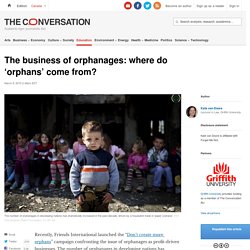
The number of orphanages in developing nations has dramatically increased in the past decade, but where are the “orphans” coming from? In 2009, Save the Children reported that internationally four out of five children living in orphanages were not orphans. Good Intentions, Questionable Results: Uganda Cracks Down on Unlicensed Children’s Homes.
KAMPALA, UGANDA—In late July, government social welfare officials stormed Hope Center Uganda, a children’s home managed by an American board of directors.

The officials say they found children eating lunch at 5 p.m. – hours past the normal time –and filthy rooms, shattered windows and too-small, uncovered mattresses. “The institute wasn’t registered and therefore unknown to the ministry,” says Freeman Arthur Kato, a children’s welfare official in the Ministry of Gender, Labor and Social Development’s Alternative Care Department.
“Someone tipped us about it.” By the end of the day, the home was closed. The 19 children who lived there were taken to Watoto Ministries, a large organization that runs several children’s homes, according to a government official. But the story of Hope Center Uganda didn’t end there, says Steve Wells, an American who is a board member of Hope Center. “We were very confused,” Wells says. “We don’t know why we were shut down,” Wells says. Lumos CEO presents at One Young World 2017. UBS. It is a common fallacy that orphanages are the only, and most beneficial, solution for abandoned and orphaned children.
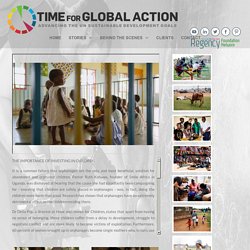
Pastor Ruth Kahawa, founder of Smile Africa in Uganda, was dismayed at hearing that the cause she had steadfastly been campaigning for - ensuring that children are safely placed in orphanages - was, in fact, doing the children more harm than good. Research has shown that orphanages have an extremely detrimental effect on the children residing there. Dr Delia Pop, a director at Hope and Homes for Children, states that apart from having no sense of belonging, these children suffer from a delay in development, struggle to negotiate conflict and are more likely to become victims of exploitation. 100&Change: The Finalists Live Presentation. The babies who suffer in silence: how overseas orphanages are damaging children. Millions of children are locked away in orphanages – this must change. I will never forget my first visit to an institution for children with disabilities in Eastern Europe.
There were dozens of children, lying awake in the middle of the day, in a dark room. None of them made a sound. No talking, no crying, no moaning, no television or radio, nothing. Orphan Industrial Complex Kristen Cheney. Why Christians Are Abandoning the Orphanage. Global context - The Indonesian Orphanages Research Hub. Fact_sheet_-_residential_care_Cambodia. Early institutional care and the developing brain. MK: Do these negative effects tend to persist throughout adulthood, or is there a chance that the affected children will later recover? NT: At the point of adoption when children first emerge from institutional care settings, they’re at risk for a number of developmental delays. They’re often physically small for their age and can have motor, language, cognitive, and emotional difficulties. But the families who adopt internationally are a very special group in that they tend to come from higher socioeconomic backgrounds and have great desire to provide caregiving.
Parents go through a lot to be able to adopt internationally and it’s not easy, so there’s already a great deal of parental investment there. Haiti's unregulated orphanages spur child abuse: report. Changing the Way We Care. Kicked Out: From Care to Chaos (2017) BBC Documentary. ChildSafe Movement - Don't Create More Orphans. Lumos Funding Haitian Orphanages 2017. Charities and voluntourism fuelling 'orphanage crisis' in Haiti, says NGO. Charitable givers from the US who believe they are helping Haitian orphans are instead funding the abuse and neglect of children at orphanages in the Caribbean country, a report from the NGO Lumos has found. At least 30,000 children live in privately-run orphanages in Haiti, a country that has suffered multiple natural disasters displacing many families. More than a third of Haiti’s 752 orphanages are funded by donations from abroad amounting to $70m (£54m), 92% of which comes from philanthropic and charity givers in the US.
But an estimated 80% of the children living in these facilities are not actually orphaned: they have one or more living parent, and almost all have other relatives, according to the Haitian government. Lumos, the NGO founded by author JK Rowling, campaigns for an end to the institutionalisation of children. It believes this not only hinders a child’s development, but makes them more likely to experience abuse. Why there is no need for orphanages in Africa. The world must wake up to the dangers of orphanages. A series of harrowing headlines about children in institutions taught us one thing last week - governments must urgently commit to a world without orphanages. Last Wednesday's blaze at the government-run Hogar Seguro Virgen de Asuncion children’s home, in San Jose Pinula, killed more than 40 teenage girls. Police say the fire started after young residents rioted and set mattresses ablaze in a bid to escape the overcrowded institution.
It followed news headlines from the UK’s Independent Inquiry into Child Sexual Abuse (IICSA), which heard how thousands of British children deported to Australian orphanages between 1947 and the 1970s suffered widespread physical and sexual abuse. Then, on Friday, just when it seemed headlines about child care had hit an all-time low, news spread of a mass grave for 800 infants in a former Catholic Church care home in Tuam, Ireland. 2017 Children in formal care estimate numbers Child Abuse and Neglect.pdf. Ending institutional care in Africa. Funding Orphanages: Is it helping or hurting? By Lydia Dean – Co-founder GoPhilanthopic Foundation People are drawn to give where there is need, but they do so emotionally and often without the needed experience or ability to monitor.
We are raising our voices for more Informed Philanthropy. This means that donors need to be more intellectually invested in their giving, they need to ask more questions, probe more, learn more, be more diligent and active. Philanthropy can be dangerous if it is passive, causing more harm than we could ever know… From our very beginning, GoPhil has focused its support towards the most at risk and vulnerable sectors of society. Over the years we have visited hundreds of long-term child care programs and have formed close partnerships with a few across Cambodia, Uganda and India.
What to look for? Global Orphan Crisis - Facts and Statistics. The facts and statistics surrounding the Global Orphan Crisis can be hard to understand and easily misinterpreted. This can lead to misinformed advocacy efforts and poor policy making, even by those with the best intentions. This straight-forward article is designed to ‘clear up the confusion’ when it comes to global orphan statistics. Cambodia Action Plan UNICEF 2017. Cambodia Mapping Report UNICEF 2017. ChildSafe Movement - The Orphanage Industry. Children need Families not Orphanages.
Supporting Vulnerable Families. Drivers of Institutionalisation. Lumos global orphanage problem factsheet. Children in Institutions factsheet Lumos. Why it is crucial to end orphanage-style care systems in Europe – EURACTIV.com. For 800 years, the problem of orphanages has been underestimated and misunderstood. Columbia University Mailman School of Public Health. Georgette Mulheir: The tragedy of orphanages. Paper Orphans- part 1. Why We Need to End the Era of Orphanages. Children need Families not Orphanages. Join our Worldwide Campaign to End the Institutionalization of Children! - Disability Rights International. Paper Orphans: Exploring Child Trafficking for the Purpose of Orphanages. Copy of 'Addicted to Orphans': The Orphan Industrial Complex and Donor Influence in Uganda's Child Protection System by Rob Oliver on Prezi. The "Orphan" Generation in Cambodia. A quiet, but alarming, trend is happening in Cambodian “orphanages.” Cost of institutions v cost of community based care Lumos 2016.
Orphanage trafficking page from Lumos 2016 report on Haiti. After the Fire Survivors of Hogar Seguro Virgen de la Asunción at risk – Findings and Recommendations for Action Better Care Network. Better Care Network Families Not Orphanages J Williamson. CRIN 2017 care institutions Europe when the state doesnt care. HRW 2017 report on Armenian orphanages. International Child Campaign Projects summary. Lumos 2014 Ending the Institutionalisation of Children Globally. Lumos 2016 Haiti Trafficking Report FRENCH. Lumos Report Children in Residential Care. Relaf Unicef 2015 institutions in Latin America in Spanish.
Rethink Orphanages 2016 Mapping Australia’s support for the institutionalisation of children overseas. Save the Children Keeping Children Out of Harmful Institutions. UNICEF 2016 Cambodia MAPPING REPORT residential care. Orphanage 'recruited kids to get donations' How Orphanage Life Affects Children. Entering and spending time in an orphanage is a life-changing experience. As an adult, meeting the children who live there, seeing their reality, witnessing the depth of their need for permanency changes you. You can never go back to not knowing. Orphanage life also changes another population, the children who live there. If you have adopted a child out of an orphanage, are in the middle of the adoption process, or are even just thinking about adopting, there are some things you need to know about the effects of orphanage life on children.